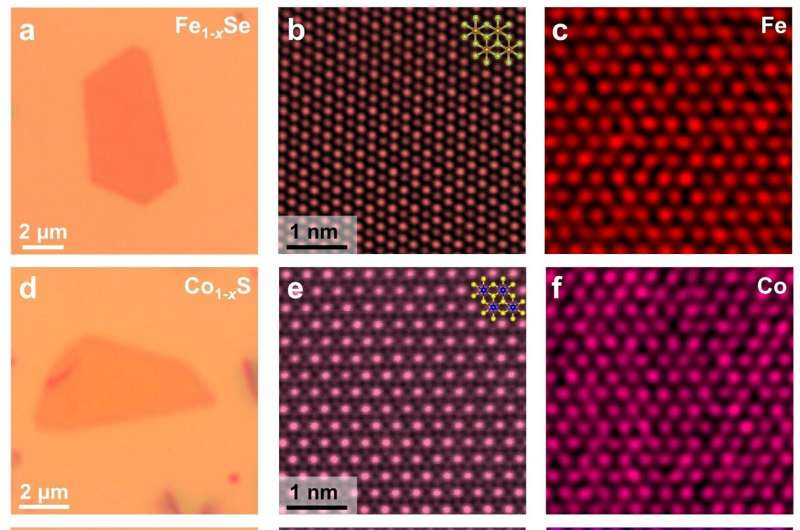Researchers developed a universal dual metal precursor method to grow non-layered 2D materials

Two-dimensional transition metal chalcogenides (2D TMCs) have drawn great interest due to their abundant material choices and possible use in many areas like electronics and optoelectronics. As a complement to the widely-studied layered TMCs (e.g., MoS2), non-layered TMCs are unique. They exhibit unsaturated dangling bonds on the surface and strong intralayer and interlayer bonding.
So far—limited by established preparation methods—the investigations of these non-layered TMC materials mainly remained on bulks or polycrystalline films, hindering the exploration of their physical characteristic and properties at the 2D thickness limit. In a recent paper published in Science Bulletin, a group led by Profs. Bilu Liu and Hui-Ming Cheng from Tsinghua-Berkeley Shenzhen Institute (TBSI) of Tsinghua University and Profs. Junhao Lin and Yue Zhao of Southern University of Science and Technology have developed a novel dual-metal precursors method, which realizes the controllable growth of various non-layered 2D TMCs, including Fe1-xS, Fe1-xSe, Co1-xS, Cr1-xS, and V1-xS.
In this dual metal growth method, the mixture of low-melting-point metal chloride and the corresponding high-melting-point metal powder was used as the dual-metal precursors. During the gas-phase reaction process, the evaporation rate was well controlled to provide a constant metal source feed and facilitate the growth of non-layered 2D TMCs with thin thickness. Taking hexagonal Fe1–xS as an example, the thickness is down to 3 nm with a lateral size up to >100 μm.
Thanks to the ultrathin nature and flat surface of the obtained flakes, the structure and transport behaviors of Fe1-xS at the 2D thickness limit were measured at the first time. Advanced microscopy inspections revreal that intrinsic ordered cation vacancies exist in the non-layered TMC family. In stark contrast, anion vacancies (S, Se, and Te) are well-known dominant point defects in common layered TMCs like MoS2. Low-temperature transport measurements and theoretical calculations reveal that 2D Fe1–xS is a semiconductor with a narrow bandgap of 20–60 meV. Compared to other narrow bandgap 2D materials like 1T’-MoTe2 and black phosphorus, 2D Fe1–xS shows better air stability and thermal stability. This work essentially solves the problem of growing ultrathin non-layered materials, and thus provides material basis for both fundamental study and applications of these emerging family of non-layered 2D materials.
Air-stability of sodium-based layered-oxide cathode materials
Junyang Tan et al, Dual-metal precursors for the universal growth of non-layered 2D transition metal chalcogenides with ordered cation vacancies, Science Bulletin (2022). DOI: 10.1016/j.scib.2022.06.022
Citation:
Researchers developed a universal dual metal precursor method to grow non-layered 2D materials (2022, August 29)
retrieved 30 August 2022
from https://phys.org/news/2022-08-universal-dual-metal-precursor-method.html
This document is subject to copyright. Apart from any fair dealing for the purpose of private study or research, no
part may be reproduced without the written permission. The content is provided for information purposes only.
For all the latest Science News Click Here
For the latest news and updates, follow us on Google News.

